Here’s what Pi sounds like:
[youtube wK7tq7L0N8E]
Here’s what Pi sounds like:
[youtube wK7tq7L0N8E]
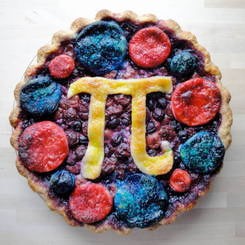 The websites Serious Eats and Instructables have held a Pi Day Pie Contest the past couple of years. (Pi Day commemorates the mathematical constant π — 3.14159… — and is held on March 14.) That’s the winner from 2010 to the left. A friend gave me a Pi pie plate several years ago, and I’ve been making a special pie in it every March since then. While many of the entries for past years have nothing to do with Pi (just pie), I liked this One-Hundred-Digit pie The websites Serious Eats and Instructables have held a Pi Day Pie Contest the past couple of years. (Pi Day commemorates the mathematical constant π — 3.14159… — and is held on March 14.) That’s the winner from 2010 to the left. A friend gave me a Pi pie plate several years ago, and I’ve been making a special pie in it every March since then. While many of the entries for past years have nothing to do with Pi (just pie), I liked this One-Hundred-Digit pie
|
And especially the ingredients for Pie to Seven Decimal Points, 3.1415926:
In honor of Pi Day (3/14)
3 different fruits
1 basic pie crust recipe
4 ingredients in the crumb topping
1 nutty ingredient
5 unique layers (bottom crust, three fruits, crumb topping)
9 added flavors in the fruit layers (3 in each)
2 ingredients in common in all the layers (butter and sugar)
6 (or 7) ingredients in the pie crust recipe, depending on whether you count water as an ingredient, and whether you round up (the next digit is 5.)
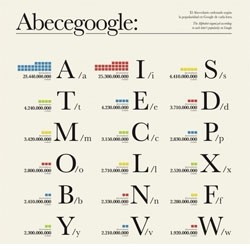 smäll has an alphabet poster ordered according to popularity for each letter in Google search. (Their site is in Spanish, try using Google translator to read it in English). Without thinking much, you would probably guess that the one letter words A and I are miles ahead of any other searched letter (over 25 billion each). It falls off very quickly, with S, T and E at 4 billion (smäll speculates that S is third as it’s the abbreviation of saint and street). Look here to see the number of searches for all letters and the numbers 0-9.
smäll has an alphabet poster ordered according to popularity for each letter in Google search. (Their site is in Spanish, try using Google translator to read it in English). Without thinking much, you would probably guess that the one letter words A and I are miles ahead of any other searched letter (over 25 billion each). It falls off very quickly, with S, T and E at 4 billion (smäll speculates that S is third as it’s the abbreviation of saint and street). Look here to see the number of searches for all letters and the numbers 0-9.
![]() Maybe more interesting would be an alphabet poster of the most searched words starting with each letter of the alphabet. (Check out Google Zeitgeist to see some of the phrases that were used most in searches in 2010.)
Maybe more interesting would be an alphabet poster of the most searched words starting with each letter of the alphabet. (Check out Google Zeitgeist to see some of the phrases that were used most in searches in 2010.)
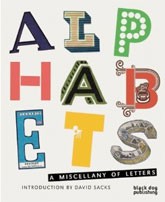 |
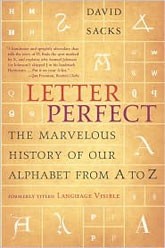 |
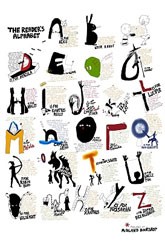 |
The first books I made were alphabet books — mostly 26 pages, each with an illustration or some content related to a specific letter. About this time of year, I pull out my list of alphabet book ideas to see if one of them moves me to work on one or another of them. This time I decided to print my alphabet poster in some new colors. I’ll post pictures in the next few days.
![]() I thought I bookmarked an interesting alphabet book I’d seen featured on someone’s blog a week or so ago . Alas I didn’t. I spent some time today trying to re-find the book, to no avail. But I found some other interesting ABC-ish things along the way.
I thought I bookmarked an interesting alphabet book I’d seen featured on someone’s blog a week or so ago . Alas I didn’t. I spent some time today trying to re-find the book, to no avail. But I found some other interesting ABC-ish things along the way.
![]() Top left, David Sacks’ Alphabets: A Miscellany of Letters, that combines a bit of history of alphabets with illustrations by many artists. You can see images from the book here and here.
Top left, David Sacks’ Alphabets: A Miscellany of Letters, that combines a bit of history of alphabets with illustrations by many artists. You can see images from the book here and here.
![]() In the middle is another book by Sacks, Letter Perfect, a history of the Roman alphabet. What I found interesting here is that the Kindle version looks to be a reformated version of the book. Which makes sense for a book with illustrations. I wish all books that had font changes or illustrations did that (I read Jill Lepore’s Blindspot on my Kindle, which alternates narrators in each chapter. In the print version, this is made obvious by the use of different fonts. On the Kindle — with only one font face — the book was confusing going until someone told me about the print version.)
In the middle is another book by Sacks, Letter Perfect, a history of the Roman alphabet. What I found interesting here is that the Kindle version looks to be a reformated version of the book. Which makes sense for a book with illustrations. I wish all books that had font changes or illustrations did that (I read Jill Lepore’s Blindspot on my Kindle, which alternates narrators in each chapter. In the print version, this is made obvious by the use of different fonts. On the Kindle — with only one font face — the book was confusing going until someone told me about the print version.)
![]() On the right is Hemant Anant Jain‘s poster The Reader’s Alphabet. Each letter represents a famous literary character and a little text summarizes the story of the book in which the character appears. You can see a large version here.
On the right is Hemant Anant Jain‘s poster The Reader’s Alphabet. Each letter represents a famous literary character and a little text summarizes the story of the book in which the character appears. You can see a large version here.
![]() And finally, this story about Ceejay Epton who, after having a baby decided to change her name to “help him learn the alphabet.” The new name: “Ceejay A Apple B Boat C Cat D Dog E Elephant F Flower G Goat H House I Igloo J Jellyfish K Kite L Lion M Monkey N Nurse O Octopus P Penguin Q Queen R Robot S Sun T Tree U Umbrella V Violin W Whale X X-Ray Y Yo-Yo Z Zebra Terryn Feuji-Sharemi”
And finally, this story about Ceejay Epton who, after having a baby decided to change her name to “help him learn the alphabet.” The new name: “Ceejay A Apple B Boat C Cat D Dog E Elephant F Flower G Goat H House I Igloo J Jellyfish K Kite L Lion M Monkey N Nurse O Octopus P Penguin Q Queen R Robot S Sun T Tree U Umbrella V Violin W Whale X X-Ray Y Yo-Yo Z Zebra Terryn Feuji-Sharemi”
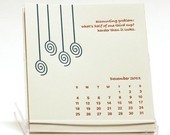 If you haven’t gotten a calendar for 2011, mine are now on sale for $15. See more pictures and information here. If you haven’t gotten a calendar for 2011, mine are now on sale for $15. See more pictures and information here.
|
Kyle Durrie of Power and Light Press recently funded a new project called Moveable Type: cross country adventures in printing through Kickstarter, a sort of social network site for raising money for small projects. Her description of the traveling venture:
“My plan is to build a mobile print shop in the back of an old delivery truck. Within these tight quarters, I’ll create an efficient and fully functional shop, with a small table top press for printing smaller work, and a larger proof press, capable of printing larger posters.
And then I’ll take this rig on the road! I plan on visiting schools, art spaces, city parks, music festivals, craft shows, parties, and anywhere else that might have an interest in learning about printing.”
See more about the project here.